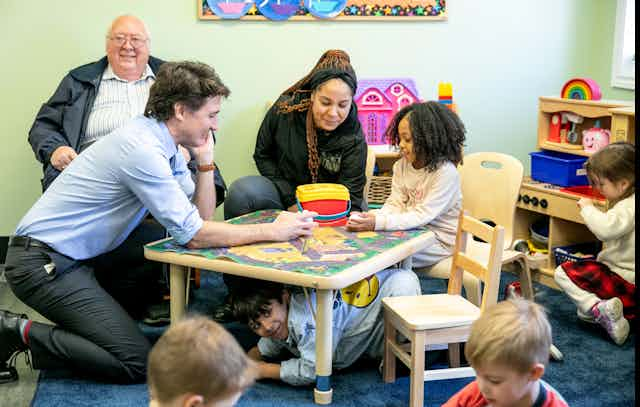Three years after the federal government launched the Canada-wide early learning and child-care plan (CWELCC), our study conducted through the Atkinson Centre for Society and Child Development at the University of Toronto finds mixed results in terms of the plan’s ambitions to improve families’ access to affordable child care. Across the country care is less expensive, but finding it is more difficult.
Early Childhood Education Report highlights
Our Early Childhood Education Report with detailed profiles for each province and territory, identifies developments in child-care enrolment, affordability, funding, workforce compensation, administration and quality by province and territory.
As researchers on this project, we reviewed all data related to the above to capture changes to services from March 2020 to March 2023. We then met with directors of early childhood policy in each province or territory to score how each is doing on a 15-point scale.
New Brunswick leads with 13.5 points, a record achievement reflecting its efforts to support child-care operators to add spaces, while supporting program quality. Overall, the provinces east of Ontario rank higher than the rest of the country.
All provinces and territories have met their affordability targets. Parent costs were reduced by 50 per cent by the 2022 deadline. Except for Québec and the Yukon, where parents were already paying below $10 per day, Nunavut, Saskatchewan, Manitoba, Prince Edward Island, Newfoundland and Labrador, and most recently the Northwest Territories, have all dropped child-care fees to an average of $10 per day, well ahead of the 2026 schedule.
Big savings, difficulty finding care

While parents with access to child care are enjoying savings; those looking for care are frustrated. More than 60 per cent of parents wanting child care reported difficulties finding it, up from 53 per cent in 2019. As a result, roughly one in three respondents said they had to change their work or study schedules, work fewer hours, or delay their return to work.
The CWELCC plan for 250,000 new child-care spaces by 2026 — for children from infancy to five years of age — is also having mixed success. By March 31, 2023, halfway through the plan’s time frame, 97,859 spaces have been added for this age group.
Prince Edward Island, Alberta, the Yukon and the Northwest Territories are on track to exceed the new space targets set out in their child-care agreements. Expansion is curtailed where governments offer insufficient funding to meet the actual cost of new builds and renovations.
Staffing shortages
The major roadblock to opening new spaces, however, is staffing shortages. Difficulties finding and keeping staff directly impact child care availability, stability and quality. Without educators, centres operate with reduced enrolment, impacting their financial viability. Program quality is compromised when government exemptions allow centres to run without the legislative requirements for qualified staff.
The federal government has given one-off infusions to help stem the workforce exodus. Most jurisdictions have used the money to improve educator wages.
In addition, Prince Edward Island has joined Québec and Manitoba in developing a sector pension plan. Prince Edward Island and Québec have benefit plans. Nova Scotia’s pension and benefit plans are in development.
Few topping up federal funds
Provincial and territorial governments complain there is not enough money in the CWELCC agreements to accomplish everything promised. We question the claim when some jurisdictions are not using the federal funding available to them. Governments have added just over $4.5 billion to their child-care spending since 2020, well below the $15 billion available to date through CWELCC.
Read more: Ontario's child-care agreement is poised to fail low-income children and families
If concerns about funding is pressing provincial and territorial governments could, of course, add their own funding, but few have done so. Relying on federal funds is now the norm.
Uneven implementation of a new social program isn’t new. The hope is that some jurisdictions will use the Canada-wide opportunity to do child care very well, becoming models to envy and emulate.
This is the fifth edition of the Early Childhood Education Report which has been released every three years since 2011. We meet with government policymakers in between reports to review data, and update the methodology to reflect any policy changes. The next report will be released in 2026.

